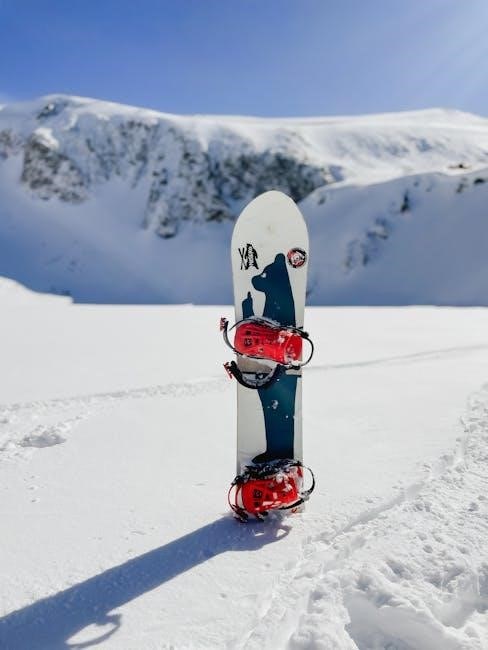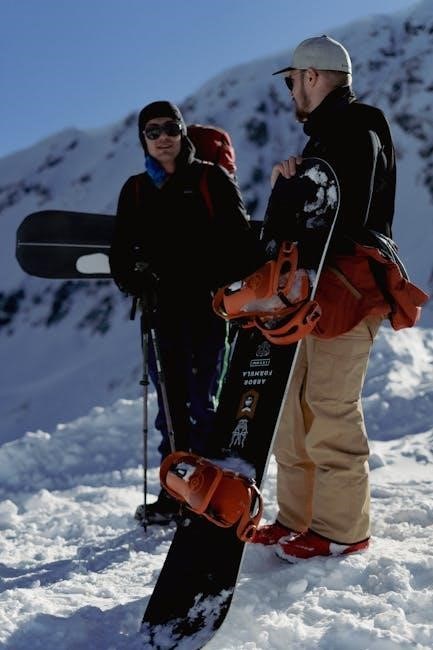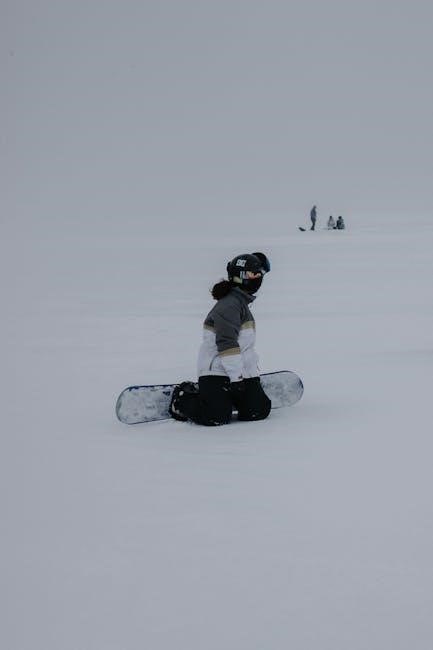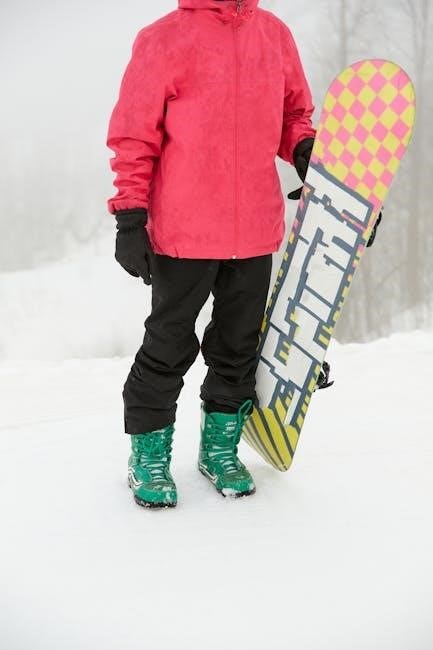


Choosing the right snowboard binding size is crucial for performance and comfort. Binding size depends on your boot size, ensuring a snug fit without overhang. Use manufacturer size charts and test bindings if possible for the best fit.

Understanding Boot Size and Binding Compatibility
Understanding boot size and binding compatibility is the foundation of selecting the right snowboard bindings. Boot sizes vary between brands, so it’s essential to refer to the manufacturer’s sizing chart for accurate measurements. Generally, bindings come in three sizes: Small, Medium, and Large, corresponding to boot sizes ranging from 5-7 (Small), 8-10 (Medium), and 11+ (Large). However, sizes can differ slightly by brand, so always check the specific recommendations for your boots and bindings. A proper fit ensures your boot sits snugly within the binding, avoiding overhang or excessive movement, which can affect performance and comfort. If your boot is too small or too large for the binding, it may lead to poor control or discomfort on the slopes. Some bindings, like automatic models, offer universal compatibility, but most require careful matching. Testing bindings with your boots before purchase is highly recommended to ensure compatibility and optimal fit. Remember, boot fit and binding size are closely linked, so prioritize this step for a seamless riding experience.
General Guidelines for Choosing Snowboard Binding Sizes
Choosing the right snowboard binding size involves aligning your boot size with the binding’s capacity. Generally, bindings are categorized into Small, Medium, and Large, corresponding to boot sizes 5-7, 8-10, and 11+, respectively. However, sizes can vary slightly by brand, so always consult the manufacturer’s sizing chart for precise measurements. It’s also important to consider the type of boots and bindings you’re using, as some systems (e.g., strap-in or step-on) may have specific compatibility requirements. A proper fit ensures your boots sit snugly within the bindings without overhang or excessive movement, which can compromise performance and comfort. Additionally, stance width and riding style may influence your binding size choice. For example, a wider stance might require slightly larger bindings to accommodate the positioning. Always test bindings with your boots if possible, as this ensures the best fit and comfort for your snowboarding experience.
How to Measure Your Boot Size for Bindings

Accurately measuring your snowboard boot size is essential for selecting the right bindings. Start by removing your socks and placing your foot flat on a hard surface. Use a ruler or a Brannock device to measure the length of your foot in inches or centimeters. Ensure your foot is weighted evenly, as this will provide the most accurate measurement. For added precision, measure both feet, as they may differ slightly in size. Once you have your foot length, compare it to your boot’s internal measurements, which are usually provided by the manufacturer. Keep in mind that snowboard boots often have a snug fit, so your boot size may not directly match your everyday shoe size. Additionally, consider the thickness of your socks, as this can affect how your foot fits into the boot and binding. By accurately measuring your boot size, you can ensure a proper fit in your bindings, which is critical for both performance and comfort on the slopes.

The Importance of Stance and Binding Fit
Your snowboarding stance and how your bindings fit are critical for comfort, control, and performance on the mountain. A proper stance allows for better balance, maneuverability, and responsiveness, while ill-fitting bindings can lead to discomfort and reduced performance. Start by ensuring your bindings are adjusted to match your boot size, leaving minimal gap but avoiding pressure points. The stance width and angle should align with your riding style—wider stances often provide stability, while narrower stances enhance carving ability. Experiment with your stance to find what feels most natural and comfortable for you. Additionally, ensure your bindings are mounted correctly on your snowboard, as improper alignment can affect how the board responds to your movements. A well-fitted binding setup not only improves your riding experience but also reduces the risk of fatigue and discomfort during long days on the slopes. Taking the time to fine-tune your stance and binding fit can make a significant difference in your overall snowboarding performance and enjoyment.
Matching Bindings to Your Snowboard’s Hole Pattern
Ensuring your snowboard bindings are compatible with your board’s hole pattern is essential for proper installation and performance. Most snowboards feature either a 4×4 or 2×4 hole pattern, while some Burton boards use The Channel system. Burton bindings designed for The Channel require specific hardware, and adapters may be needed for compatibility with other systems.
To avoid installation issues, check your snowboard’s hole pattern before selecting bindings. Some bindings come with multi-disc bases that fit multiple patterns, offering versatility. Mismatched bindings can lead to poor performance or damage. Always consult compatibility guides or manufacturer charts to ensure a proper fit. This step is crucial for optimal control and safety on the slopes.
How Riding Style Impacts Binding Size
Your riding style significantly influences the choice of snowboard binding size and stiffness. Freestyle riders often prefer softer, more flexible bindings for easier maneuverability and tricks, while all-mountain riders benefit from medium to stiff bindings for better control at higher speeds. Freeride and powder enthusiasts typically opt for stiffer bindings to maintain stability in challenging terrain. The binding’s flex rating should align with your riding style to ensure optimal performance. Riders who prioritize precision and responsiveness may lean toward smaller, more responsive bindings, while those seeking forgiveness in varied conditions might prefer a slightly larger size for comfort. It’s essential to match the binding’s flex and size to your style to maximize control and enjoyment on the mountain. Always consider how your riding preferences impact your binding choice to ensure a tailored fit and enhanced performance.
Using a Snowboard Binding Size Chart
A snowboard binding size chart is an essential tool to determine the correct binding size for your boots. These charts typically categorize bindings into Small, Medium, and Large, with specific boot size ranges for each category. For example, Small bindings might fit boot sizes 5-7, Medium for 8-10, and Large for 11-13. However, sizes can vary slightly between brands, so it’s crucial to refer to the manufacturer’s specific chart. To use the chart effectively, measure your boot size accurately and match it to the corresponding binding size. Some charts may also ask for your boot brand, as certain brands have unique sizing. By following the chart, you can ensure a proper fit, avoiding both overly tight bindings that cause discomfort and overly loose ones that lack responsiveness. Testing the bindings with your boots is recommended if possible, but a reliable size chart is the next best option for a precise match.
Boot Fit and Comfort in Bindings

Ensuring proper boot fit and comfort in snowboard bindings is vital for a enjoyable and performance-driven riding experience. A snug fit prevents excessive movement, which can lead to poor control and discomfort. Boots should fit securely into the bindings without causing pressure points or restricting circulation. If the boots are too loose, they may slip out of the bindings, compromising stability and response. Conversely, if they are too tight, it can lead to discomfort and fatigue during long rides.
To achieve optimal fit, consider the shape and flex of both the boots and bindings. Softer boots may require slightly tighter bindings, while stiffer boots might need a bit more room for proper responsiveness. Adjusting the straps and highbacks can also help customize the fit. Testing bindings with your boots before purchase is highly recommended to ensure compatibility and comfort. Pay attention to how your feet feel during the ride—proper fit should allow for smooth, natural movement without sacrificing support or control.
Testing Bindings Before Purchase
Testing snowboard bindings before purchasing is a crucial step to ensure they meet your needs and preferences. This process allows you to assess compatibility with your boots, snowboard, and riding style. Visit a store with your boots and snowboard to try out different binding models.
When testing, pay attention to how the bindings feel with your boots. Check for proper fit—snug but not overly tight. Ensure there’s no excessive boot overhang and that the straps and highbacks adjust comfortably. Ride the board to gauge responsiveness and support. If the bindings feel too stiff or too soft, they may not suit your riding style.
Additionally, verify that the bindings are compatible with your snowboard’s hole pattern. Mount them temporarily to ensure proper alignment and functionality. Testing bindings also gives you an opportunity to evaluate features like ease of entry, strap comfort, and adjustability. Spending a few minutes to test bindings can make a significant difference in your overall riding experience and satisfaction.